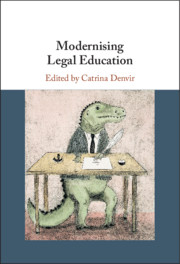Book contents
- Modernising Legal Education
- Modernising Legal Education
- Copyright page
- Contents
- Figures
- Tables
- About the Contributors
- Foreword
- Introduction
- 1 Do Lawyers Need to Learn to Code?
- 2 Experiential Legal Education
- 3 Skills Swap?
- 4 Scaling the Gap
- 5 Bringing ODR to the Legal Education Mainstream
- 6 Design Comes to the Law School
- 7 Developing ‘NextGen’ Lawyers through Project-Based Learning
- 8 Same As It Ever Was?
- 9 Ludic Legal Education from Cicero to Phoenix Wright
- 10 The Gamification of Written Problem Questions in Law
- 11 Virtually Teaching Ethics
- 12 Paths to Practice
- 13 ‘Complicitous and Contestatory’
- Afterword
- References
8 - Same As It Ever Was?
Technocracy, Democracy and the Design of Discipline-Specific Digital Environments
Published online by Cambridge University Press: 30 December 2019
- Modernising Legal Education
- Modernising Legal Education
- Copyright page
- Contents
- Figures
- Tables
- About the Contributors
- Foreword
- Introduction
- 1 Do Lawyers Need to Learn to Code?
- 2 Experiential Legal Education
- 3 Skills Swap?
- 4 Scaling the Gap
- 5 Bringing ODR to the Legal Education Mainstream
- 6 Design Comes to the Law School
- 7 Developing ‘NextGen’ Lawyers through Project-Based Learning
- 8 Same As It Ever Was?
- 9 Ludic Legal Education from Cicero to Phoenix Wright
- 10 The Gamification of Written Problem Questions in Law
- 11 Virtually Teaching Ethics
- 12 Paths to Practice
- 13 ‘Complicitous and Contestatory’
- Afterword
- References
Summary
In the field of educational technology there are classic oppositions that shape what we do in our use of technology in higher education (HE) – behaviourism versus constructivism, open versus for-profit, conventional versus innovative curriculum design, technocracy versus democracy. Both sides of the binaries are critical components of what we might determine as the ‘social’ in HE, and the extent to which their oppositions govern our approach to curriculum design also determines the type of learning that our students undertake in their programmes. In this chapter we explore the effect of the antinomies on the development of simulation software designed and built last decade and still in use at Strathclyde Law School, and adapted elsewhere. The chapter will analyse the assumptions and the history – legal educational, technological and social – that are part of the software build and outline future use and expectations for the software as it develops beyond what might, to date, be characterised as its early beta or incunabula stages of development in HE. Above all we shall begin to trace what we hope is one resolution of the classic opposition of technocracy and democracy, a theme that will be developed in future publications.
Keywords
- Type
- Chapter
- Information
- Modernising Legal Education , pp. 147 - 165Publisher: Cambridge University PressPrint publication year: 2020
References
- 1
- Cited by

